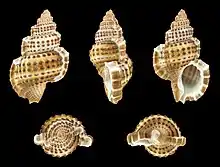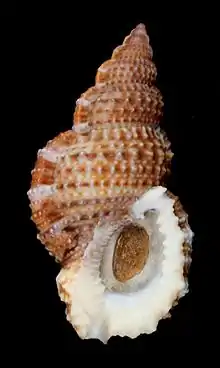| Dulcerana granularis | |
|---|---|
 | |
| A shell of Dulcerana granularis (Röding, 1798) | |
| Scientific classification | |
| Domain: | Eukaryota |
| Kingdom: | Animalia |
| Phylum: | Mollusca |
| Class: | Gastropoda |
| Subclass: | Caenogastropoda |
| Order: | Littorinimorpha |
| Family: | Bursidae |
| Genus: | Dulcerana |
| Species: | D. granularis |
| Binomial name | |
| Dulcerana granularis (Röding, 1798) | |
| Synonyms[1] | |
| |
Dulcerana granularis, common name the granular frog shell, is a species of medium-sized sea snail, a marine gastropod mollusk in the family Bursidae, the frog shells.[1]

Apertural view of Dulcerana granularis (Röding, 1798) with operculum.
Distribution
This marine species occurs in the Indo-West Pacific, off New Zealand, in the Caribbean Sea, the Gulf of Mexico and the Lesser Antilles.
Description
Habitat
Minimum recorded depth is 0 m.[2] Maximum recorded depth is 256 m.[2]
References
- 1 2 MolluscaBase eds. (2023). MolluscaBase. Dulcerana granularis (Röding, 1798). Accessed through: World Register of Marine Species at: https://www.marinespecies.org/aphia.php?p=taxdetails&id=1472303 on 2023-07-20
- 1 2 3 Welch J. J. (2010). "The "Island Rule" and Deep-Sea Gastropods: Re-Examining the Evidence". PLoS ONE 5(1): e8776. doi:10.1371/journal.pone.0008776.
- ↑ New Zealand Mollusca: Bursa gramularis
- Lamarck J.B. (1816). Liste des objets représentés dans les planches de cette livraison. In: Tableau encyclopédique et méthodique des trois règnes de la Nature. Mollusques et Polypes divers. Agasse, Paris. 16 pp
- Dautzenberg, Ph. (1929). Contribution à l'étude de la faune de Madagascar: Mollusca marina testacea. Faune des colonies françaises, III (fasc. 4). Société d'Editions géographiques, maritimes et coloniales: Paris. 321–636, plates IV-VII pp.
- Spry, J.F. (1961). The sea shells of Dar es Salaam: Gastropods. Tanganyika Notes and Records 56
- MacNae, W. & M. Kalk (eds) (1958). A natural history of Inhaca Island, Mozambique. Witwatersrand Univ. Press, Johannesburg. I-iv, 163 pp.
- Drivas, J. & M. Jay (1988). Coquillages de La Réunion et de l'île Maurice.
- Michel, C. (1988). Marine molluscs of Mauritius. Editions de l'Ocean Indien. Stanley, Rose Hill. Mauritius
- Steyn, D.G. & Lussi, M. (1998) Marine Shells of South Africa. An Illustrated Collector’s Guide to Beached Shells. Ekogilde Publishers, Hartebeespoort, South Africa, ii + 264 pp. page(s): 72
- Brook, F.J., Marshall, B.A. 1998 The coastal molluscan fauna of the northern Kermadec Islands, southwest Pacific Ocean, Journal of the Royal Society of New Zealand, 28 (p. 221)
- Beu, A.G. 1998 Indo-West Pacific Ranellidae, Bursidae and Personidae (Mollusca: Gastropoda): A monograph of the New Caledonian fauna and revisions of related taxa, Mémoires du Muséum National d'Histoire Naturelle, 178 (p. 150)
- Spencer, H.; Marshall. B. (2009). All Mollusca except Opisthobranchia. In: Gordon, D. (Ed.) (2009). New Zealand Inventory of Biodiversity. Volume One: Kingdom Animalia. 584 pp
- Rosenberg, G., F. Moretzsohn, and E. F. García. 2009. Gastropoda (Mollusca) of the Gulf of Mexico, Pp. 579–699 in Felder, D.L. and D.K. Camp (eds.), Gulf of Mexico–Origins, Waters, and Biota. Biodiversity. Texas A&M Press, College Station, Texas.
External links
Wikimedia Commons has media related to Dulcerana granularis.
- Branch, G.M. et al. (2002). Two Oceans. 5th impression. David Philip, Cate Town & Johannesburg
- Röding, P. F. (1798). Museum Boltenianum sive Catalogus cimeliorum e tribus regnis naturæ quæ olim collegerat Joa. Fried Bolten, M. D. p. d. per XL. annos proto physicus Hamburgensis. Pars secunda continens Conchylia sive Testacea univalvia, bivalvia & multivalvia. Trapp, Hamburg, viii + 199 pp
- Perry, G. (1811). Conchology, or the natural history of shells: containing a new arrangement of the genera and species, illustrated by coloured engravings executed from the natural specimens, and including the latest discoveries. W. Miller, London, 4 pp. + 61 pls
- Dunker, W. (1862). Species nonnullae Bursarum vel Ranellarum collectionis Cumingianae. Proceedings of the Zoological Society of London. 1862: 238-240
- Röding, P. F. (1798). Museum Boltenianum sive Catalogus cimeliorum e tribus regnis naturæ quæ olim collegerat Joa. Fried Bolten, M. D. p. d. per XL. annos proto physicus Hamburgensis. Pars secunda continens Conchylia sive Testacea univalvia, bivalvia & multivalvia. Trapp, Hamburg, viii + 199 pp
- Sanders M.T., Merle D., Laurin M., Bonillo C. & Puillandre N. (2021 (nomenclatural availability: 2020) ). Raising names from the dead: a time-calibrated phylogeny of frog shells (Bursidae, Tonnoidea, Gastropoda) using mitogenomic data. Molecular Phylogenetics and Evolution. 156: 107040: 1-12
This article is issued from Wikipedia. The text is licensed under Creative Commons - Attribution - Sharealike. Additional terms may apply for the media files.